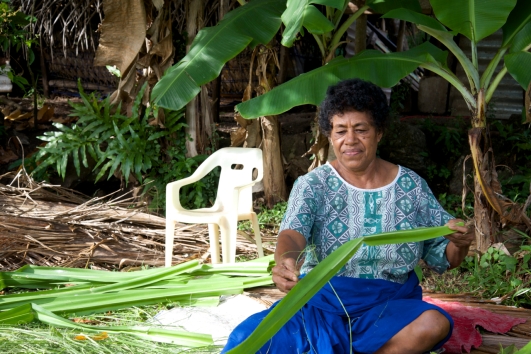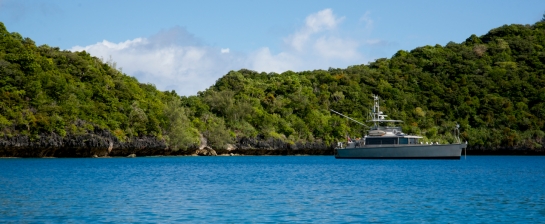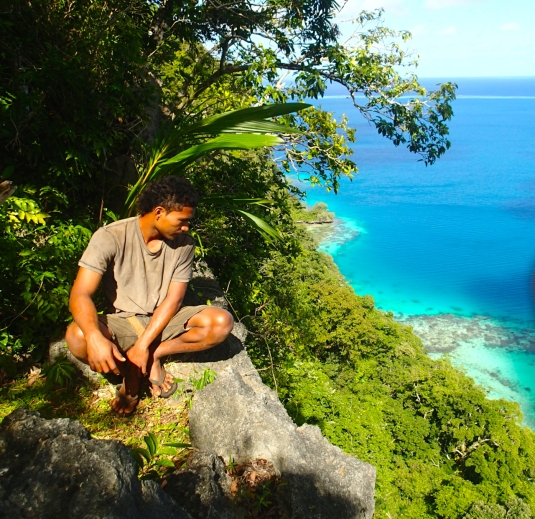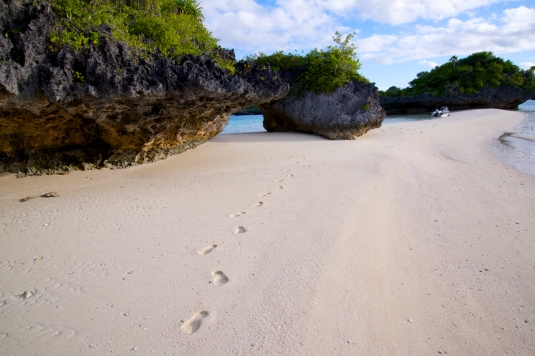From Viani Bay, we made our way southeast to the island of Vanua Balavu (VAH-noo-ah bah-LAH-voo) in the northern Lau group. The Lau group is the easternmost group of islands in Fiji, reportedly the least visited islands in the South Pacific. This is in large part because (as related to us by one of the Lau’s village chiefs) several decades ago, recreational drugs were brought ashore by some cruisers. This caused quite a stir among the very conservative Fijian villagers, resulting in the chief of the entire Lau group ordering the whole group closed to all tourism thenceforth. For the past several years they have tried to relax this strict isolationist policy, first by issuing only a handful of permits annually to a very few lucky cruisers, then as of last year, opening it up on request to all cruisers holding Fijian cruising permits. Since one still has to clear into Fiji in the middle or western islands, then travel a couple hundred miles against the prevailing trade winds to get here, the Lau group is still a relatively remote destination.
There are no resorts per se, and only two or three of the islands have small air strips where a plane makes a stop, weather permitting, once weekly. Failing that, the only access is to book passage on a cargo ship, which makes the trip about once a month to deliver supplies to the islands. So outside of visiting yachts tourism is quite rare, though no doubt this will change over the years to come.
On the map above, we have drawn a crude line around the entire Lau Group of Fiji.
We considered our personal holy grail in the Lau group to be Fulaga in the southern Lau, and normally would have made straight for that island, bypassing the others in favor of spending all our time in Fulaga. But Fulaga has no airstrip at all, the closest one being 100 miles north. Jeff and Julie would likely need to head back to the States before we’d want to leave the Lau group altogether, so to avoid anyone feeling ‘stuck,’ we traveled first to Vanua Balavu: closer, with a weekly flight to Suva, and one of the more developed islands in the Lau. By developed, we mean there are a few select locations where you can pick up a cell signal, one of the villages has a couple of stores where basic staples like flour, rice and eggs can be had. And we could buy fuel for our outboards at the bakery (the fuel prices written on the same hanging whiteboard as the bread prices, how cute is that?)
We stopped first at Daliconi village to present our sevu-sevu (our offering of kava to the chief) in order to anchor in the lovely nearby waters known as the Bay of Islands.

The Bay of Islands has no sandy beaches, but does have lots of sculpted rocks and mushroom shaped tiny islands with trees on them. The network of islands and channels, completely undeveloped and pristine, combined with lovely blue and turquoise water, lends a fantasy-kingdom feel to the place.
Working our way around the island over the next several days, we finally, FINALLY caught up with our friends John and Kathy on Mystic Moon. Mystic Moon is a Selene 53, sister ship to our last boat Pax Nautica. Though we reunited with John and Kathy over New Year’s in the States, we haven’t cruised with them since 2007 in California’s Channel Islands, so we were excited to anchor next to them once again.
Buffalo Nickel looks relatively puny in the photo due to perspective: Mystic Moon is 60 feet overall length, Buffalo Nickel 68. Getting the boat tour with Jeff and Julie while we were aboard lovely Mystic Moon for cocktail hour one evening, Jeff asked me “How does it feel to be aboard a Selene now?” I told him that, though we are over the moon about Buffalo Nickel and wouldn’t trade back for anything, it made my heart ache just a little bit.
Which it did. Then I felt like a jerk for having that reaction. I felt like Midlife Guy, who adores wife number 2 but gets jealous when he hears that wife number 1 has a boyfriend. It’s possible I need therapy for some of this.
Anyway, while in Bavatu Harbor, we hiked up a 272 step stairway built into the jungle, constructed to provide access for the villagers between the shore and their so-called ‘caretaker village.’ It isn’t a separate village per se, but rather a permanent outpost with a cluster of houses for the villagers who take care of the village’s plantation, which is where they grow their coconuts, fruits and vegetables, and maintain their livestock.


We brought a couple of gifts for the head caretaker, who gave us bananas and paw-paws in exchange. He was also kind enough to send his son with us to continue our hike to some lookouts with vistas over both the Bay of Islands and Bavatu Harbor.


Along the trail, we sampled some of the local fruits. One of them, if we understood him correctly, was called sour-soap. Sounds unappetizing, like something your parents might force you to eat if you use foul language, but actually was refreshing and delicious. Our intrepid guide scampered up a coco palm at one point, knocking off a coconut for each of us, then smartly lopping their tops off with his machete so we could quench our thirst.
The island produces and exports copra, which is the part of the coconut consisting of the meat and inner hull. They dry it in the sun, after which it will be processed (probably in Suva) to extract the coconut oil.

Next up: Susui Island, in which Jeff and Julie bid us “adieu for now,” abruptly terminating their crew contracts and leaving us to fend for ourselves in a strange land tropical paradise.
In unrelated news, several folks including personal friends, cruising acquaintances and offline communications from blog followers, have requested that we specifically speak to the comparison from a practical cruising standpoint between a traditional trawler (such as a Nordhavn, or a Selene which we spent over six years cruising) and our FPB, after our first season in Fiji and three blue water passages.
We made several promises to do that, which as it turns out we have no intention of keeping, at least not in this blog forum. I actually wrote just such a blog post, we spent a whole lot of time distilling our personal experiences as a cruising couple with our boats and their various systems, composing the piece and editing it… but were never truly pleased with the implied message, no matter how I wordsmithed it to achieve the tone we were striving for.
What I WILL say, and call it good, is simply in response to what we think is a misperception among many of those who cruise under power. In fact, it’s such a common misperception that Stan and I both shared it, even as we signed on the dotted line to purchase our own FPB. I’m tempted to go all shouty-caps with that last sentence because it’s just that true and that important in relation to our perspective as it stands today.
That perception is that an FPB is all about the blue water passages. That it will make ocean crossings more comfortable and safe (and therefore more commonly undertaken,) at the expense of some of the creature comforts enjoyed during other aspects of cruising: namely, an interior, exterior and systems designed for stylish and convenient living aboard, spacious and welcoming enough for entertaining, and practical for playtime at anchor.
And again, we were operating under that same assumption when we decided to sell our Selene and buy an FPB. Yes, I did crawl around a couple of the 64’s and conclude that I could live aboard one of these boats, but at first glance I still assumed I could live aboard happily despite some sacrifices. The layout and flow is different enough from a trawler that any more was hard to assess in advance; and when it comes to systems and power management routine it’s challenging to really judge for yourself until you live with them. This statement applies to both Stan with his ‘blue jobs’ and myself with the ‘pink jobs’ as we have a more or less traditional division of onboard activities along gender lines. Which reminds me, we are a couple cruising together almost never accompanied on our passages. We might entertain one or more other couples from the anchorage aboard on occasion, and we try to get our adult kids and their plus-ones to spend a week or so with us each when they can, but we cruise basically as a couple, for about 7 months at a stretch; not a couple-plus-crew, and not a family, so all my remarks should be interpreted in that context.
But what we’ve found, both of us, is that in practically every area, our at-anchor and live aboard experience, in terms of day to day life on the water, entertaining, maintenance and other chores, our FPB experience is even less hassle, less work, more comfortable and generally more pleasurable for us than aboard our trawler. And make no mistake, we LOVED Pax Nautica.
In other words, what many assume and what we ourselves assumed, is that with an FPB, time underway would be safer and more comfortable, BUT that we would make small sacrifices in terms of aesthetics and living space, in an environment less well suited to enjoyable time spent at anchor engaged in all the many leisure and labor activities that constitute the cruising life. But that this trade-off would be worth it in our particular case, as we would feel less inhibition in making offshore passages and therefore seek more adventure.
Here’s how our statement reads today: with our FPB, time underway is spent in greater safety and comfort, AND we feel we have a better living space, in an environment better suited to enjoyable time spent at anchor engaged in all the many leisure and labor activities that constitute the cruising life.
As to what we didn’t like about our more in-depth comparison piece between our two boats, juxtaposing our experiences as cruisers (not as designers or engineers,) in each area and system, it comes down to this: no matter how we tweaked it, it sounded like we were trying to define what constitutes an adequate, or an ideal, cruising motor yacht. And that just doesn’t sit well with us.
What comes to mind is an experience we had recently at a crowded dock party in Whangarei, New Zealand. We happened to be in conversation with a sailing friend, and standing next to one of the FPB 64’s recently splashed and about to set off on her first season (not our own boat, which was hauled out in the yard at the time.) Another unknown sailor approached, and our friend remarked to him, cocking his head toward the FPB: “Great looking boat, isn’t she? Are you familiar with these?” To which the newcomer shrugged and replied: “I don’t know… but it’s certainly not a CRUISING boat.”
Comfortable in my anonymity, I asked, “Really? What makes you say that?”
He said to me something along the lines of “That boat would never survive the kinds of conditions you encounter when you’re passage making offshore. Most people don’t even know what it’s like. Have YOU ever been in 25 meter seas?”
Pleased with my Yankee self for doing the math so quickly he might not even have seen me squinting or my lips moving, I answered, “75 foot waves? No… and I hope I never do.” I laughed (this being an un-winnable argument, not to mention a ridiculous turn of conversation,) and quickly tried to change the subject.
You see, he had constructed a ‘clubhouse for cruisers’ with his arbitrary definition of offshore sailing and I was not going to be allowed into the club. And maybe I’m NOT in the club, what do I know? All I can say with assurance is that one of the things we love most about cruising is that it’s such an inclusive activity. When we make new friends in an anchorage, everyone seems to focus on our commonality and on shared experience. Not what we do or did for a living, where we were educated, how big the men’s water makers are or any of the other things that separate and stratify us.
We’re really not into the exclusive game. In our view we are all headed for the same destination. Some of us under sail, some under power. Some faster, some slower. In various sizes, shapes, ages and pedigrees of vessel. Some of us with lifelong boating experience while the rest of us just muddle through somehow. But we all arrive, over the water, and almost without exception we’ve had a great time doing it. We had the time of our lives cruising on Pax Nautica, figured cruising for us couldn’t get much better than that. And then we met Buffalo Nickel, and lo and behold, it did. We hope to see you out there!










Thank you for these well written and beautiful photographed account of the outter islands.
Judy and I had a Blue Lagoon cruise into the Yazawa island group ten years ago and it was magic.
What you are doing is a great adventure. Please keep the logs coming.
Bula Buffalo Nickel!
Let me know if you need crew for a passage.
Jim
Great pictures, excellent post! Not only is your writing providing us a taste of your cruising, your pictures are becoming a feast to our eyes.
More in particular, I liked your sincere dissertation about your time spent on diverse boats – even if a bit “politically-correct”.
Still, I remain curious: from a “value-for-the-money” perspective (Warren Buffet-like point-of-view), how would similar-sized (length) FPB and Nordhavn compare?
Sure, safety is important. But I think you agree with me that safety has more to do with the person in command, who makes the “go, no-go” decision, than the vessel.
And regarding comfort, as you compare your experiences with those who came before you, wouldn’t you agree that time spent passage making between destinations is but a small percentage of the time spent onboard?
Your comments are appreciated. And if you prefer, you can respond offline.
Robert
Hi Robert, happy to hear you’re enjoying our blog. The value for money assessment will be difficult for me to make, not in small part because I don’t know really what a Nordhavn 62, say, would go for. The new vessel price is available of course, but that’s oranges to apples because of outfitting and spares, included with the FPB and not with the Nordhavn. Those could be calculated, and maybe when when we’re feeling less lazy we will do so! I’m just guessing that the Nordhavn similarly outfitted would run a bit less money but not much in the scheme of things. Our own choice, even when we perceived the FPB would be a space and convenience sacrifice for us, makes our views clear. Boats are no kind of sound financial investment 😉 but in terms of resale value, I’d say as of now we are very comfortable we could get top dollar in short order for our boat. But boats are like babies, it never makes financial sense to have one. Given that, one might as well buy exactly the boat one wants and can afford, right?
Safety I would say, and also the feeling of security that comes with safety, is dependent on both the person in command and the vessel. A faster boat, as a general example, is inherently safer in terms of rough weather avoidance than a slower boat. Unless you never make a ‘go’ decision, one day you will have to deal with the scenario where the weather changes after departure or defies the forecasts.
Agreed that open ocean passage making is a small percentage of cruising time. But you do raise a good point in that the comfort issue comes into play just as much on short jaunts while coastal cruising as during blue water days. Some of our more challenging conditions have been during weekend jaunts between Ventura, CA and the Channel Islands. Besides, for me, I’m far more likely to opt in on an adventure if I’m not dreading the discomfort of it so much… and since the passage is buying me the destination, that means I look forward to visiting more (and more remote) destinations. Thanks for the discussion Robert!
Thank you Valerie. The HEMINGWAY DAIQUIRI recipe is great tasting!!!
So glad you enjoyed it. Cheers!